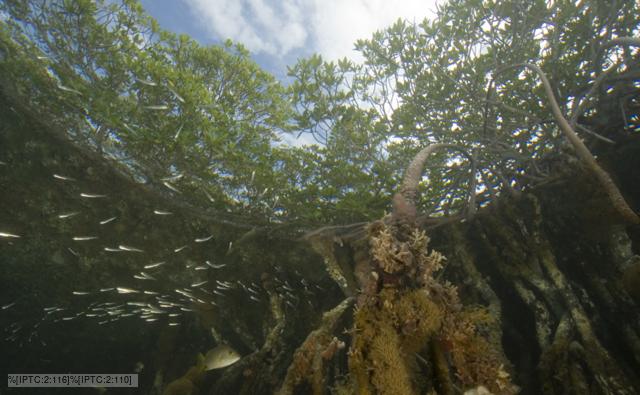With sea level rise comes the inevitable change in environmental conditions and pressures, with shores and coastlines at the forefront of the threat and therefore likely to be most affected. One such ecosystem selective to coastlines is those of Mangrove Forests. Mangals (Mangrove Forests) are extremely selective in the sense that they are highly adapted to saline conditions and thus can only form around coastlines in intertidal environments.
The distribution of mangroves globally is controlled by the 20° isotherm with mangrove forests found extensively around tropical coastlines, extending into subtropical areas as far north as st. Georges Parish (32° 23’N) in Bermuda and as far south as Corner Inlet (38° 45’S) in Australia (Woodrolfe, 1990). Whilst abundant along shorelines they are particularly well developed in muddy and well sheltered areas of coast with a large supply of fine grained, silty sediment. They can however also form on peat, sand and coral substrates.
 |
| Map Showing World Distribution of Mangrove Forests Source: (Giri, et.al, 2011) |
As sea levels rise mangrove forests are being placed under increasing stress. This is due to the numerous negative effects seawater can have on coastal areas, including; sediment erosion, the inundation of habitats by seawater and increasing salinity levels in landward zones (Ellison, 1994). These effects put these ecosystems and the services they provide under threat. Services such as;
- Trapping sediment, therefore sustaining offshore water quality for coral reefs,
- Providing nursery habitats for fish and invertebrates that spent maturity in coral reef environments,
- Acting as flood and surge protection for inland areas.
Mangrove forests can also be used as building materials, traditional medicines, firewood and as sources of food (Ellison, 1994).
 |
| Mangrove Forests as seen from below Source: BBC Nature |
It has been predicted that these coastal ecosystems are therefore likely to migrate landward as their former habitats become increasingly marine, this process will occur through the vertical accretion of sediments held by the extensive mangrove roots.
However this retreating movement is hindered by an effect coined ' coastal squeeze', which means that their landward migration is becoming increasingly restricted by topography or human developments. (Ellison, 1991). With these woodlands now no longer able to shift inland as outer pressures increase, the question is where can/will they go?
 |
| Mangrove destruction on Bimi Source: Kristine Stump |
On another note however it must be said that currently the biggest threat to these diverse ecosystems is not sea level rise but human destruction of these coastal ecosystems to make room for our ever expanding populations (Luther, 2009).
This is a major issue in Southeast Asia as well, with organizations planning trips to mangrove forests to help pick up rubbish that people have discarded or that have been transported through waterways.
ReplyDeleteAnother interesting post Cat! Thanks for sharing. You might like this webpage about Mangrove forests in Austrailia. http://www.mangrovewatch.org.au/index.php
ReplyDeleteoption=com_content&view=category&layout=blog&id=26&Itemid=30016
From what i have read they are really crucial habitats and are currently under-protected and there is not enough scientific research about them.
Do you think that Mangroves will migrate inland at the same rate as sea-level rise? Or will we lose a lot of this important habitat? What do you think the consequences of this will be?